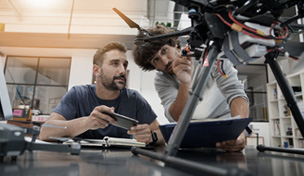Process
The Technology Transfer Process
CURF is here to protect your IP and add value to your project. You can engage with us at any point during your research, but we recommend contacting our offices early. By engaging our office early in the project, we can help you avoid challenges and pitfalls that may compromise your ability to protect your IP.
An invention has to make sense in the world it finishes in, not in the world it started.
- Tim O'Reilly
Step 1
Submit an Invention Disclosure
The first step in the technology transfer process is a completed Invention Disclosure Form.
The more information you provide to us upfront, the more quickly we will be able to evaluate your inquiry and provide service. You may hear from us during this time to ensure a clear understanding of the disclosed invention. Once the disclosure has been accepted, you will receive an electronic notice that all required information has been received for processing. We recommend you take the invention disclosure tutorial before submitting a disclosure.
Step 2
Assigning Your Disclosure
Next, we assign your disclosure to a Technology Commercialization Officer (TCO) for review.
Disclosures processed the previous week are presented and assigned every week.
Step 3
The Inventor/TCO Meeting
We’ll contact you to schedule a meeting with your Technology Commercialization Officer.
We'll contact you for a meeting with a Technology Commercialization Officer (TCO) within two weeks of the official disclosure acknowledgement. Your initial TCO meeting is an informal, confidential discovery session that helps us learn more about your IP, your goals as a researcher, and possible commercial applications for your technology.
Step 4
Opportunity Assessment
The CURF team evaluates your IP.
Our opportunity assessment is based on many factors, including patentability, marketability, and potential return on investment (ROI). During the assessment process, we give you the opportunity to provide more information if questions arise. We won’t leave you in the dark; you’ll receive our thorough assessment whether or not we choose to move forward with financial investment to formally protect your disclosed IP (e.g. patent prosecution, copyright registration), and commit personnel time and effort to commercialize your technology.
Step 5
Moving Forward / Inventor Pitch
If we decide to move forward, we will invite you back to our office to pitch your technology.
You’ll have the opportunity to pitch to the CURF team and outside subject matter experts. To help you, we provide a presentation template to follow as well as our feedback and any market research data we have gathered. Our hope for this pitch meeting is that, together, we can identify the best path forward, keeping in mind that our decision process is driven by our ability to realize a favorable ROI. It is not our practice to make financial investments to protect IP that does not have an attractive commercialization profile.
Step 6
Obtaining the Patent & Licensing Agreement
At this point, the process becomes completely collaborative.
We identify a patent attorney most suited to work with you on crafting the patent application. After filing the application, we work with you to identify the best path forward to mature the technology toward licensing and commercialization.
Step 7
Ongoing Collaboration
This is the fun part - visualizing your IP entering the marketplace.
We seek licensees that can collaborate with you to further develop the technology and introduce the technology to market. We also handle all compliance terms and conditions related to the license: collecting licensing fees and royalties, ensuring non-financial adherence to non-financial obligations, and distributing any licensing and royalty income (per the University Intellectual Property Policy).








